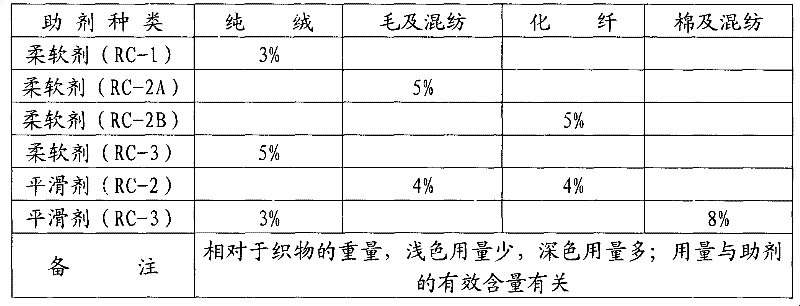Low-temperature after finishing method of textiles
A textile and finishing technology, applied in textiles and papermaking, fiber processing, dry cleaning fiber products, etc., can solve the problems of fabric weight loss, non-biodegradation, large water consumption, etc., to reduce energy consumption and pilling. , the effect of weight loss reduction
- Summary
- Abstract
- Description
- Claims
- Application Information
AI Technical Summary
Problems solved by technology
Method used
Image
Examples
Embodiment 1
[0027] Example 1: For knitwear
[0028] 1. Milling
[0029] a) Bath ratio: 1:25 (medium water level);
[0030] b) Temperature: normal temperature (0°C-20°C);
[0031] c) Shrinkage agent
[0032]
[0033] d) Time: In order to pursue a more excellent soft effect, it is recommended to soak for 20 minutes before stirring. There are two ways to choose the stirring time according to the actual situation: use shrinking to make the suede in place in one step, and the turning time depends on the size of the suede. , this situation means that the fabric is soaked in a static state (such as in a pool) when it is soft; the agitation is for the purpose of cleaning, and it takes 3-5 minutes. If the suede is insufficient, it can be made up by agitation when it is soft. This is when the fabric is softened in the washing machine;
[0034] e) Dehydration: high-speed dehydration, strive to minimize the liquid-carrying rate, subject to no foam overflow;
[0035] f) Rinse: rinse with cold ...
Embodiment 2
[0049] Embodiment two: for cloth
[0050] 1. Shrink it
[0051] a) Bath ratio: 1:1 (that is, the weight of water is the same as that of cloth);
[0052] b) Water temperature: normal temperature (0°C-20°C);
[0053] c) shrinking detergent
[0054]
[0055] d) Time: 30-40 minutes (depending on suede and shrinkage);
[0056] e) Rinsing: 10 minutes;
[0057] f) Dehydration: high-speed dehydration, and strive for the lowest liquid-carrying rate.
[0058] 2. Transfer to drying, ironing and fluffing process
[0059] 6.3 Soft finishing
[0060] a) Bath ratio: about 1:15 (that is, the amount of water should be controlled to just submerge the cloth);
[0061] b) Temperature: normal temperature (0°C-20°C);
[0062] c) The amount of softener and smoothing agent
[0063]
[0064] d) Time: 30-40 minutes.
[0065] 4. Transfer to the processes of thorn fruit pulling water pattern, dehydration, drying, and debossing.
[0066] 5. Description
[0067]If special functional treat...
PUM
 Login to View More
Login to View More Abstract
Description
Claims
Application Information
 Login to View More
Login to View More - R&D
- Intellectual Property
- Life Sciences
- Materials
- Tech Scout
- Unparalleled Data Quality
- Higher Quality Content
- 60% Fewer Hallucinations
Browse by: Latest US Patents, China's latest patents, Technical Efficacy Thesaurus, Application Domain, Technology Topic, Popular Technical Reports.
© 2025 PatSnap. All rights reserved.Legal|Privacy policy|Modern Slavery Act Transparency Statement|Sitemap|About US| Contact US: help@patsnap.com



